It’s not unusual to leave things for the next visitors to a bothy, or find things left by others, and sometimes that includes books. This one, named ‘Shelter Stone: The Artist and the Mountain’, has quite a few differences though.

It’s a 66 page newsprint publication featuring outdoor-related contributions from 46 artists and poets, and the paper it’s printed on is made from 70% midge trap waste. That’s right, midges. This seems like a pretty elaborate and brutal form of revenge – going to nibble on us, inflicting days of itching? Well then, we’ll pulp you and turn you into paper. The midges are bad enough down here in Yorkshire near Singletrack Towers, but if you’ve never experienced Scottish midges, then you should know they’re a lot bigger up there…

There’s still more to this though. Normally, book burning is absolutely not something we’d associate with bothies, artists or poets, but as well as a source of information Shelter Stone is designed as a survival tool. The creators encourage bothy visitors to, if they need to, start a fire with pages from it, or use them to dry their boots.
We asked creator and co-curator Edward Summerton a few questions and he was kind enough to write out more details and send some images.

“The project is a collaboration between myself (The Strict Nature Reserve) and The Mountain Bothy Association, who are delivering the publications to 103 bothies across the UK. We have volunteers assisting the project by delivering them to the Alps and Iceland. We have an Icelandic and German artist involved in the publication.

“I came up with the idea for the project, firstly to try and get some sort of exhibition together that would celebrate the artists who I knew, or knew the work of that had a fascination with the mountain landscape. I was particularly interested in discovering artists who were somehow in this territory, but not recognized within their peer group.
“For example, the project, encompasses everything that we think of when we consider the relationship Crowley had with the mountain. The magical, physical, spiritual, pioneering, poetical, ritualistic interface between the artist and geology. The publication contains work by those who walk in the mountains/ live in the mountains / cycle in the mountains/ or indeed just dream about the mountains.
“Once there was enough support, I then invited the poet John Glenday, to ask if he would be interested in selecting the writers. This then gave the project another dimension.

“The publications are only available for viewing in these remote locations (bothies). The midyear exhibition in the DCA November 23rd is for people who cannot get access to the bothies and to offer those the chance to see the publication. At the end of the yearlong project, a copy will be presented within an exhibition in Edinburgh, within the RSA, of work by artists within the publication, but not necessarily the same work.

“I don’t intend to make any more editions of this publication project. 200 are being printed. 120 will go out to the bothies and shelters. The artists will get a copy. Some will go in archives or collections. For example – The Scottish Poetry Library want one, as will the Center for Artists books in Dundee.
“I do intend making a project based on the “artist and the bicycle” which will consider the influence the bicycle has had on contemporary artist, culture and our environment.

“Other projects over the past two decades have been celebrated for offering alternative formats for the dissemination of mine and others work. These have included “Delayed by storm” a collaborative postal art project with Don Paterson, one of the UK’s most distinguished writers, where the buyer of these very limited hand-stamped text works by Paterson had to send cash to a remote Scottish Island post office, then wait for a storm to pass the island (days, weeks, sometimes months) before the box was franked with “delayed by storm” and delivered. Or his collaboration with the artist David Faithfull, where they collected snow at mid-summer and mid-winter from the coire an t-sneachda / The corrie of the snows, high up in the Cairngorm mountain to make 183 bottles of beer from the snow to hand out free as their contribution to an international print exhibition. The collector of the prints (the bottle label) had to open and drink the beer with both the artists. The currency exchanged was the meeting of minds. As the historian Murdo MacDonald reminded us ‘those who drink together, think together.'”

There’s a little more information on the University of Dundee website too. Photos courtesy of Edward Summerton. Additional bothy photos in this story by Ben Skinner-Watts and Darren Ellis courtesy of Hannah and Ben at Flare Clothing Co.





